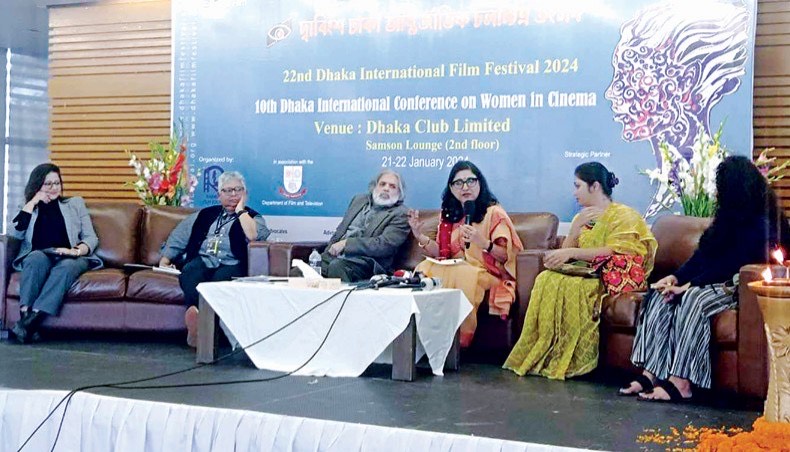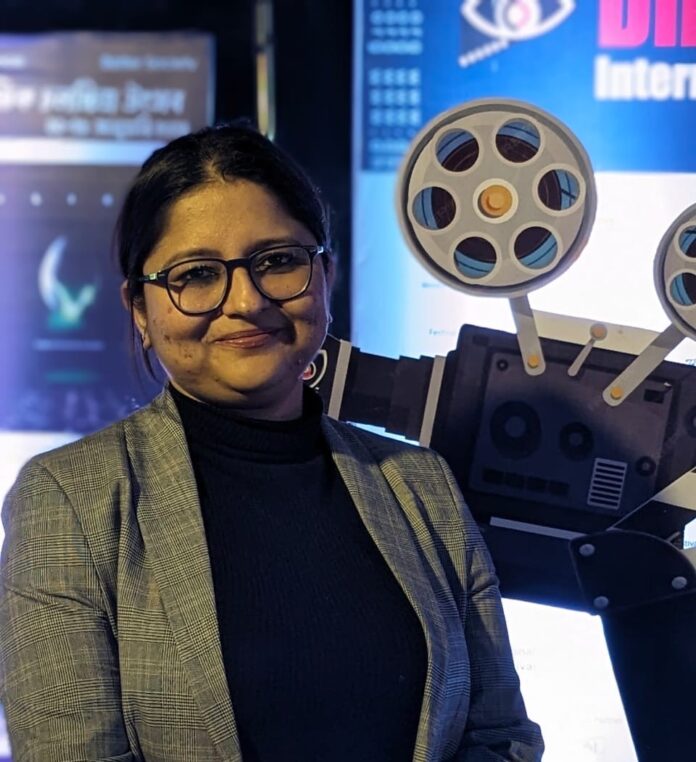Recently, Dr. Ipsita Barat, the Head of the Mass Communication & Videography Department at St. Xavier’s College (Autonomous) in Kolkata, participated in the Dhaka International Film Festival and the 10th Dhaka International Conference on Women in Cinema 2024. The conference was inaugurated by Indian actor Sharmila Tagore.
Dr. Barat holds a PhD from Jadavpur University and a master’s degree from AJK Mass Communication and Research Centre (MCRC), Jamia Millia Islamia. As an esteemed media scholar and critic, she actively engages in researching the Indian media industry and has an impressive publication record, contributing significantly to the field. Beyond her academic pursuits, Dr. Barat participates in debates and regularly contributes to various mainstream press publications.
During an insightful conversation with Shobha Akshar, a Senior Journalist representing The Interview World, held at the sidelines of the 10th Dhaka International Conference on Women in Cinema 2024, Dr. Ipsita Barat shared key highlights of the conference. She delved into topics such as the portrayal of women in Indian cinema, the environment for women artists and filmmakers, the role of filmmakers in society, and more. Now, let’s delve into the significant insights gleaned from her interview.
Q: What is your perspective on the current portrayal of women in Indian cinema? Does it align with global trends in filmmaking, or do you believe there is room for improvement?
A: Examining the portrayal of women in cinema is a crucial matter that demands attention. This encompasses both the representation of women within the industry and their depiction on the screen. To address this global concern, the Dhaka International Film Festival (DIFF) organized a conference named ‘Woman in Cinema.’ The focus of this conference was twofold: it delved into the issues of representation and the gender gap persisting in the traditionally male-dominated field of filmmaking.
A noteworthy aspect deserving commendation is DIFF’s decade-long commitment to organizing this conference. In recognition of women’s contributions to the industry, they established a distinct category titled ‘Woman films.’ This category, along with the conference, delved into the multifaceted challenges associated with women’s representation in cinema.
The landscape of women’s portrayal in Indian cinema has undergone significant transformations with the emergence of over-the-top (OTT) platforms. Women are now acknowledged as a substantial audience segment, leading to the creation of numerous films and web series with women in central roles. The conference also devoted attention to Indian cinema and web series where women are at the forefront of the narrative.
Participants from across the globe lauded Indian cinema during the conference, acknowledging its evolution from merely objectifying women to producing content that transcends traditional gender norms. These narratives delve into the intricacies of women’s lives, their struggles, and their paths to emancipation. A case in point is the 2022 web series, Qala, which offers a unique narrative that centres around women without glorifying them.
One remarkable character in Qala is portrayed by Swastika Mukherjee, depicting a mother in a manner that humanizes motherhood, devoid of societal constructs or stereotypes. This portrayal stands as an exemplar that refrains from glorifying motherhood but instead presents it as a humane aspect of life. Ms. Mukherjee, a presence at the festival, actively voiced her perspective, emphasizing the current era as a pivotal time for change.
Q: What is the current state of conditions for women filmmakers and women artists in the Indian subcontinent, and what challenges and opportunities do they face in pursuing their careers and contributing to the creative landscape?
A: For several years, I’ve grappled with a pressing question that stems from my experiences in the Hindi film industry back in 2010-11. Transitioning to academia and currently teaching filmmaking at a prestigious college in Kolkata marked a significant shift in my professional journey. Despite my departure, I’ve observed numerous female students entering the film industry and sharing their arduous experiences.
In 2023, I had the honour of being a speaker at the “Women in Cinema” conference organized by DIFF. During this event, I presented a paper titled “The Eye Behind the Cinema: Reflections on the Women Workforce of Contemporary Bengali Cinema in India.” The focus of my paper centred on female directors in Bengali cinema, delving into the distinctive discourse surrounding their work.
My exploration extended to film representations, incorporating insights from the lives of past female filmmakers like Kanan Devi, Arundhuti Devi, and Manju Dey, as well as contemporary figures such as Aparna Sen, Nandita Roy, Sudeshna Roy, and Sohini Das Gupta. A recurring theme emerged as I discovered the intertwining of personal and professional aspects in the lives of these filmmakers.
Building on this, during this year’s conference, I unveiled a new study spotlighting the personal lives of female filmmakers. The study, titled “Navigating Dual Identities: An Exploration of Intersectionality in Motherhood and Filmmaking,” scrutinizes the challenges these women face while balancing motherhood and a career in filmmaking. Utilizing intersectionality as a conceptual framework, the study aims to illuminate the struggles within this historically male-dominated industry.
I firmly believe that continued research in this realm is imperative. Such investigations are key to unravelling the roots of the gender gap and gaining a comprehensive understanding of the factors contributing to it.
Q: What were the key topics and discussions covered during the Dhaka International Film Festival?
A: During the opening seminar of the 10th Dhaka International Conference on Women in Cinema 2024, speakers emphasized the challenging nature of being a filmmaker, particularly for women. Renowned Indian actress Sharmila Tagore inaugurated the seminar, setting the tone for discussions on the hurdles faced by women in the film industry and potential solutions.
As an integral part of the ongoing 22nd Dhaka International Film Festival, the conference shed light on the historical representation of women as objects of desire in cinema and explored the evolving portrayals over the years. Beyond that, the event delved into the gender disparity prevalent in the cinema workforce, addressing the industry’s male-dominated nature and examining the underlying reasons behind this gap.
Q: How do the responsibilities of a filmmaker towards society manifest, and what criteria should guide the choice of film content? In the context of Indian cinema, including Bollywood and other film centres, to what extent do you believe filmmakers are currently meeting these responsibilities?
A: During the conference, the topic under discussion included the portrayal of women in films, particularly with a focus on male filmmakers. Shankha Das Gupta, a filmmaker from Dhaka and the director of the 2023 web series “Guti,” was posed with a question in one of the sessions. The query revolved around whether men should feel a moral obligation to depict women as empowered in their films.
Das Gupta responded by asserting that a filmmaker’s primary duty is to portray their thought process on screen, a perspective I largely agree with. However, the conversation took an interesting turn when participants referenced a mainstream Hindi film, “Animal” (2023), where a woman is depicted licking a man’s feet. This example prompted the panel to delve into the ethical considerations surrounding filmmaking.
Despite the overarching importance of projecting artistic vision, the consensus among the panellists was that ethical considerations must not be overlooked. Films, being influential, often play a significant role in shaping public opinion. Therefore, while filmmakers are driven by their creative vision, they also bear a responsibility to uphold ethical standards in their portrayal of characters, especially in the context of societal impact.
Q: What criteria define a film as ‘good’ or ‘bad,’ and what role should filmmakers play in shaping audience preferences? Is it more effective for filmmakers to create cinema that aligns with existing audience tastes, or should they strive to cultivate an audience for what is considered ‘good’ cinema?
A: The landscape of cinema has transformed over time, transitioning from a once-dominant focus on mainstream films in single-screen theatres to a rich variety of film offerings. Film festivals have played a crucial role in this evolution, serving as catalysts for introducing audiences to the vast world of cinema, thereby fostering an appreciation for alternative and international films.
With the advent of multiplexes, the viewing landscape expanded significantly, offering audiences the simultaneous screening of diverse genres. This shift also paved the way for niche cinema, tailoring film experiences to specific tastes and interests. In more recent times, the emergence of streaming platforms has revolutionized access to films, providing viewers with a personalized and convenient cinematic experience.
As a consequence of these changes, the subjective nature of film evaluation remains prominent. Audiences now have the privilege of enjoying a diverse array of cinematic choices across various platforms and genres, reflecting the dynamic and ever-changing landscape of the film industry.
Q: What strategies can young and emerging filmmakers employ to effectively balance the artistic integrity of creating issue-based films with the practical considerations of ensuring economic viability in the film industry?
A: The current state of the financial sustainability of independent films is disheartening, posing a pressing concern. Independent cinema, frequently featured in festivals, hinges on these platforms as a beacon of hope for recognition. Although festivals worldwide play a substantial role in promoting independent films, challenges emerge beyond these events. The dilemma of financial viability becomes particularly pronounced for passionate filmmakers who produce films fuelled by their love for the craft. To cope with the financial strain, many independent filmmakers resort to creating advertisements for sustenance, acknowledging the difficulty of making ends meet solely through filmmaking. This struggle vividly underscores the ongoing need for broader support systems and platforms to ensure the continued flourishing of independent cinema.



